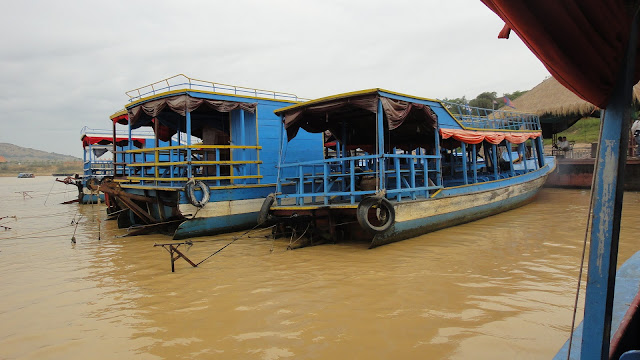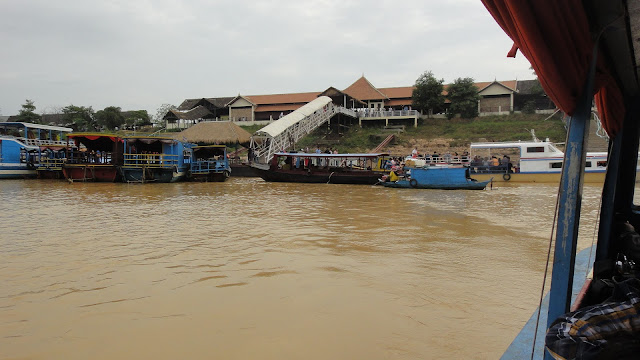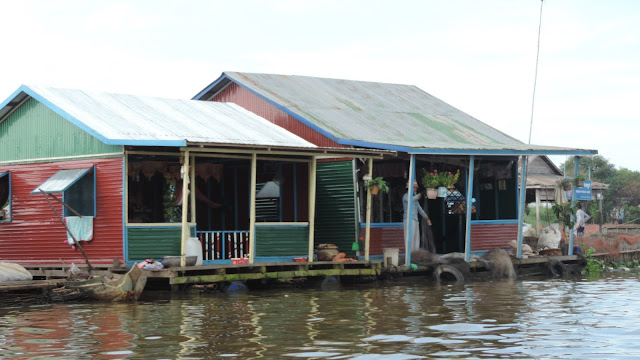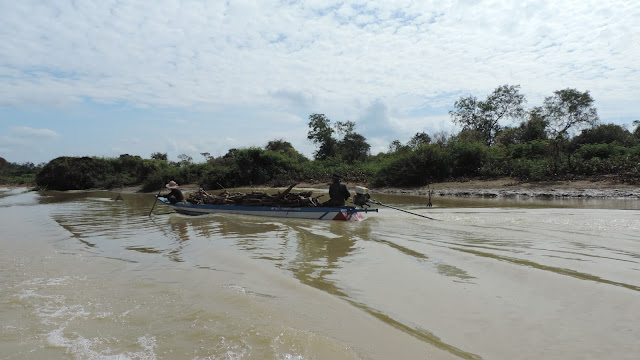The
van
picks
up
at
our
hotel
over
an
hour
late
and
after
we
have
already
phoned
the
company
to
inquire
(seems
the
driver
couldn't
find
our
hotel???)
We
bail
out
of
the
van
at
the
docks
on
the
river
and
scramble
aboard
our
boat.
Chaos
reigns
as
various
river
boats
arrive
and
depart
for
various
destinations.
The
fast
boat
to
Phnom
Penh
is
leaving
at
the
same
time
as our,
rather
smaller,
slow
boat
to
Battambang.
Our
boat
is
about
the
size
and
shape
of a
large
school
bus with
similar
seats.
There
is a
canopy
over
head
and
a
very
noisy
diesel
engine
in
the
stern.
 |
River boats similar to ours
|
 |
| Very busy at the river docks |
 |
| All settled and off we go |
We
head
down
the
river
a
short
distance
to
where
it
opens
up
into
Lake
Tonle
Sap.
The
lake
is large enough
that we
can't
see
the
far
side.
Before
reaching
open
water,
we
pass
through
the
floating
villages:
permanent
settlements
of
floating
buildings,
including
houses,
stores,
churches,
restaurants and gas
stations.
 |
| Floating restaurant |
The
voyage
across
the
lake
is
pleasant
and
uneventful;
we
reach
the
other
side
and
enter
the Sangker
River.
Our
boat
motors
for
miles
up
this
narrow
river,
almost
completely
lined
with
floating
settlements
on
both
sides.
We
literally
pass
close
to
the
front
doors
of
the
people
who
live
here. There
is
steady
traffic
of
boats
of
all
sizes in
both
directions;
everything
from
larger
passenger
boats
like
ours,
to
heavy
freight
boats
to
long
narrow boats
that
zoom
here
and
there
at
high
speed.
We
also
see
lots
of tiny
canoe-like
craft
being
paddled
by
hand
as
well
as
large
sampans
that
appear
to
have
permanent
inhabitants.




Because
of
the
shallowness
of
the
river,
all
the
boats have
long-tail
drive
assemblies.
This
is a
long
shaft
that
projects out
behind
the
boat
with
a
propeller
on
the
end
and
a
winch
that
can
raise
it up
and
down
as
required.
The
small
boats
steer
by
swinging
the
engine
like
an
outboard
and
are
powered
by
an
18
hp
utility
engine
attached
to
the
long
propeller
shaft.
Of
course,
in
the
interests
of
better
performance,
the
muffler
is
always
removed
from
the
engine,
leaving
a
bare
exhaust
port.
Occasionally,
to
make
the
exhaust
noise
more
resonant,
a
piece
of
chrome
tail
pipe
is
bolted
on.
The
boats
are
long
and
narrow,
plane
beautifully
and
travel
at
an
immense
rate
of
speed.
Fortunately,
they
are
very
manouvrable
as
the
river
is
narrow
and
congested.
 |
| Typical long-tail boat |
About
four
hours
into
our
journey,
we
arrive
at a
village
situated
at
the
confluence
of
two
rivers.
We
disembark
for
a
toilet
break
(although
I
use
the
term
loosely)
and
we
buy
soft
drinks
and
snacks.
Our
course
takes
up
the
smaller
of
the
two
branches
and
this
necessitates
our
transfer
to
two
smaller
boats. The
river
from
here
is
much
narrower,
very
winding
and,
in
places,
quite
shallow.
We
know
this
because
several
times
the
boat
runs
aground
and
has
to
be
pushed
off
the
mud
by
the
deckhands.
The
journey
is
impossibly
scenic!
We
travel
literally
through
the
heart
of
rural
Cambodia
and
it
is
endlessly
fascinating.
I
use
the
term
"endlessly"
because
by
the
time
we
pull
into
the
riverbank
in
Battambang,
some
8
1/2
hours
after
leaving
Siem
Reap, our
butts
are
sore
and
our
legs
need
stretching
and
we
are
glad
to
be
off
the
boat.
But
we
wouldn't
have
missed
it
for
the
world!




